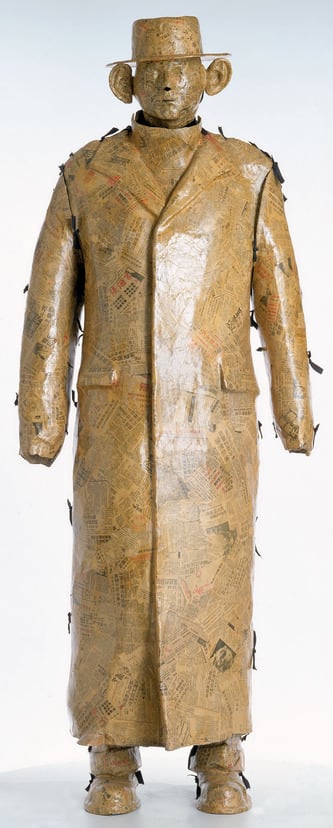
- Artist/Maker:
- Robert Wilson
- Bio:
- American, b. 1941
- Artist/Maker:
- Moidele Bickel
- Bio:
- German, 1937-2016
- Title:
- The Golem
- Date:
- 1987
- Medium:
- Papier mâché made from Chinese and Japanese newspaper, glue, and metal frame support
- Dimensions:
- 79 × 29 × 21 in. (200.7 × 73.7 × 53.3 cm)
- Credit Line:
- Purchase: Dr. Jack Allen and Shirley Kapland Fund
- Accession Number:
- 1993-275a-f
Not On View
The Golem is at once a sculpture, a costume, and a set design. This is not out of the ordinary for the objects that Robert Wilson uses in his theater productions. His intention is that they not be mere decorations but rather works of art in their own right. Most of Wilson's sculptural works to date are based on theater designs, props, and furniture. The Golem is a life-size papier-mâché sculpture made from Chinese and Japanese newspapers and was worn by an actor playing that character in Wilson's 1987 production entitled Death, Destruction, and Detroit II at the Schaubühne in Berlin. The golem appeared onstage, enclosed in the stiff hat and overcoat that was held together at the back with laces. Another character, possibly a rabbi, dressed in typical Eastern European Jewish garb, cut the lacings and removed the costume to reveal the actor-as-golem inside wearing the same (but this time real) hat and overcoat.
According to Jewish legend, the golem is an artificial being created by magic. Based on the idea that life can be fashioned from dead matter, the myth of the golem dates back to the kabbalah, the code of Jewish mysticism, which is as old as the Bible. The most well-known golem story is about the one created in the sixteenth century by Rabbi Loew, the famous Talmudic scholar from Prague. Rabbi Loew fashioned his artificial being out of clay and gave him life so that he would protect and save the Jews in Prague from those who wanted to destroy them. However, the golem became unruly, interpreting all commands too literally, so the rabbi was forced to destroy his beloved creation.
Wilson is known as a master in experimental theater, reinterpreting and deconstructing classic grand opera and dramatic literature, so that the viewer may consider these works in a new light. He has produced these plays in collaboration with many notable personalities, including Allen Ginsberg, Philip Glass, Lou Reed, and Susan Sontag. Wilson's trademark is rearranging and juxtaposing words and disparate objects to create new meanings and connections. Death, Destruction, and Detroit II is the middle work in a trilogy, the first of which was staged in 1979. The four-hour play was based on the writings-stories, letters, and diaries- of Franz Kafka, who, like Rabbi Loew, was from Prague. This "Kafkaesque" production did not follow a simple narrative, but was a series of text and images on nine separate stages. The presence of the golem character in the play evoked free associations about creation and civilization-the magical power to create a being from dust mirrors God's ability to create human life. The golem's first movements were guided by humans bearing sticks, evoking a robot, thereby raising larger questions about the choices that people make, the influences on those choices, and ultimately on free will.
According to Jewish legend, the golem is an artificial being created by magic. Based on the idea that life can be fashioned from dead matter, the myth of the golem dates back to the kabbalah, the code of Jewish mysticism, which is as old as the Bible. The most well-known golem story is about the one created in the sixteenth century by Rabbi Loew, the famous Talmudic scholar from Prague. Rabbi Loew fashioned his artificial being out of clay and gave him life so that he would protect and save the Jews in Prague from those who wanted to destroy them. However, the golem became unruly, interpreting all commands too literally, so the rabbi was forced to destroy his beloved creation.
Wilson is known as a master in experimental theater, reinterpreting and deconstructing classic grand opera and dramatic literature, so that the viewer may consider these works in a new light. He has produced these plays in collaboration with many notable personalities, including Allen Ginsberg, Philip Glass, Lou Reed, and Susan Sontag. Wilson's trademark is rearranging and juxtaposing words and disparate objects to create new meanings and connections. Death, Destruction, and Detroit II is the middle work in a trilogy, the first of which was staged in 1979. The four-hour play was based on the writings-stories, letters, and diaries- of Franz Kafka, who, like Rabbi Loew, was from Prague. This "Kafkaesque" production did not follow a simple narrative, but was a series of text and images on nine separate stages. The presence of the golem character in the play evoked free associations about creation and civilization-the magical power to create a being from dust mirrors God's ability to create human life. The golem's first movements were guided by humans bearing sticks, evoking a robot, thereby raising larger questions about the choices that people make, the influences on those choices, and ultimately on free will.
Information may change as a result of ongoing research.